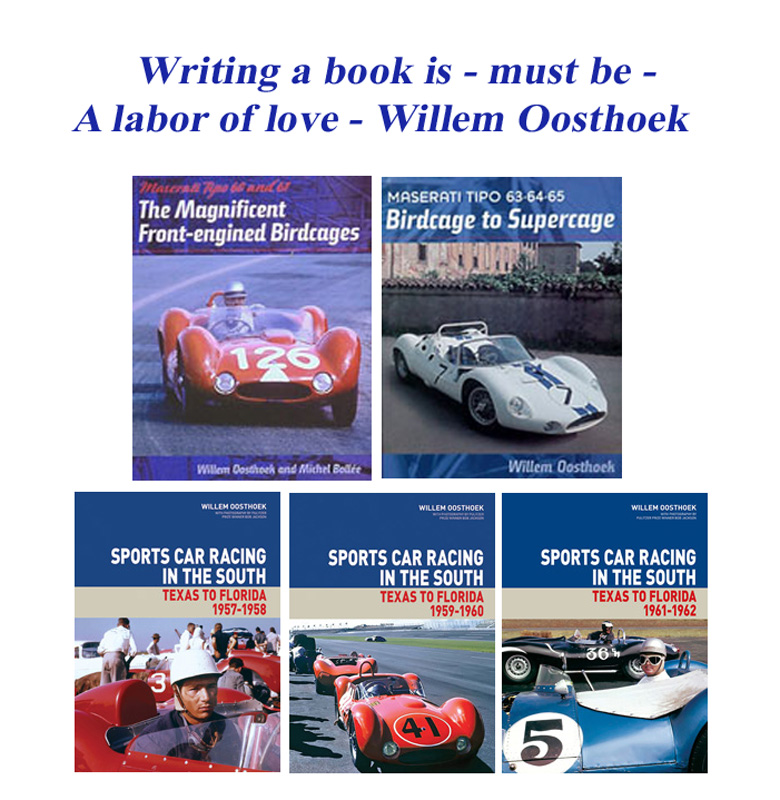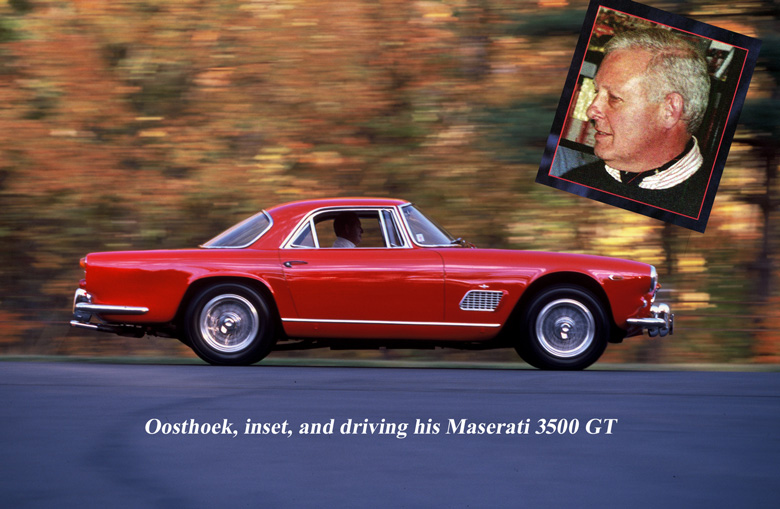Interview by Pete Vack
Portions of this interview were originally published here in 2004.
Most of us are avid readers, particularly of good, solid historical books which feature our favorite cars; the more detailed the better, with decent contemporary photos, chassis numbers, hardcore information that you can count on, preferably on nice stock and hardbound.
But few readers realize what goes into the making of such a book, and how difficult it is to find publishers. We decided to ask Maserati expert Willem Oosthoek how he did it and what kind of problems he encountered in writing his last three major works; in 2004, Birdcage to Supercage, in 2009, The Magnificent Front Engined Birdcages, and the three volume set, Sports Car Racing in the South,Texas to Florida, 1957-1962.
What drives you to write books, love, money or prestige?
This has definitely been a labor of love. There is little money in it once you begin counting the hours involved. Starting originally to satisfy my own curiosity, I noticed that nobody knew the full story and that large parts of what was available were distorted, because of misinformation in Joel Finn’s Maserati books of the seventies. So I decided the story of the “Birdcage to Supercage” had to be told.
Did anyone beside Dalton Watson want to publish your book?
Based on my experience with motor racing publishers it is surprising that ANY interesting books are being published today or will be published in the future. Much to the dismay of a number of excellent historical authors I know, the publishers seem to be more interested in their bottom line then in serving the public with new and interesting subject matters. They prefer issuing the umpteenth Ferrari book, no matter how superficial, preferably with big, often rehashed pictures and little text. Picture books are definitely the trend these days.
Robert Bentley, David Bull, Haynes Publishing, Automobilia, Palawan Press, Motorbooks International: none had the guts to tackle a detailed book on rear-engined Birdcages. An outfit like Giorgio Nada turned me down and then proceeded with publishing the mediocre Maserati book by Maurizio Tabucchi, containing so many errors that it is insulting. It makes you wonder what kind of beancounters are running these companies. They certainly don’t serve motor racing history.
Where and how did you find the photographs?
The main body of photos came from three people. Bob Tronolone is a good friend and his archives covered the West Coast races. I discovered Flip Schulke, a Time-Life photographer who did work for Car & Driver in the sixties, but who turned away from motor racing when his friend Bruce McLaren died. I tracked him down in Florida and we became friends. His work covered Sebring and Nassau. Egon Hofer in Austria owns one of the Tipo 63 cars and he has excellent archives with negatives taken by Pete Coltrin. This covered the factory and Italian testing photos. Bernard Cahier came to the rescue for the Nurburgring, and Geoffrey Goddard and my late friend Henri Beroul for Le Mans.
But photos of some races were very hard to find. Bill Green helped me with Watkins Glen. The Bridgehampton photos came from the Ludvigsen Collection in London and European friends like Michel Bollee, Walter Baumer and Andre Pibarot helped me with material from their own collections. Road America was a problem and one of the photographers, tracked down because his work appeared in the RA programs of the sixties, conceded that he had thrown it all away!
How did you manage the interviews?
As the historian of The Maserati Club I interviewed a lot of the Maserati drivers and car owners in person, while on business trips for my regular job in international banking. Even before I decided to do the book, I felt the urgency to interview the people involved, as they were not going to be around forever. If not done while I had the opportunity, many fascinating racing stories would be lost. I interviewed team owners Joe Lubin in Los Angeles and Frank Harrison in Chattanooga. I sat down with drivers like Bill Kimberly in the DC area, Jim Jeffords in Milwaukee, Bill Krause in Los Angeles and Dick Thompson in West Palm Beach. Augie Pabst was done by phone and at Monterey, and Briggs Cunningham by phone. Briggs was very pleasant and polite, but he had no real information to convey even in 1990, when he was still in good health. I also tracked down the 96-year old sister of the late Maserati France owner John Simone. She lived in Geneva, Switzerland and provided valuable information about John’s life, with rare photographs. Factory assistance was non-existent due to lack of detailed archives, although Ermanno Cozza was always eager to help.
What kind of problems did you encounter?
Apart from the problems in tracking down historical photos and a publisher, the main problem was that of solving the jigsaw puzzle of the history of these ten cars. Most of the owners had no clue, neither did the museum curators. Factory records were incomplete and Birdcage designer Ing. Alfieri had not really been involved in the preparation of these cars. Chief tester Bertocchi would have been an excellent source, but he died before I even started my research.
Were the owners helpful?
Most of them were, with the exception of Peter Kaus who never responded. This was probably because in a letter published by Classic & Sports Car magazine, I called his Tipo 151 a replica, which did not please him a bit. I was also hired as an expert by the Artom family when they threatened Bruce McCaw with a lawsuit about which Tipo 63 was the real 4th place Le Mans car in 1961. In the end the McCaw people retracted their claim. All of the cars have survived, with one being used up in the construction of the Tipo 65. Some of them have undergone marvelous restoration, but a number of the engines – 4-cylinder and V12 units – are not correct, let alone original.
In 2009 you followed that book with the “The Magnificent Front-engined Birdcages” with Michel Bollée. Can you tell us a bit about that?
Michel Bollée was really the original driving force behind this project. He had already self-published a number of Maserati books [450S, Tipo 151], but ran into financial constraints as soon as we finished the manuscript.
We had to ask Dalton Watson Fine Books if they were interested in bringing it to market and, based on the success of the rear-engined Birdcage book, they were!
What I like about this book is that it covers every single event in which a Tipo 60 and Tipo 61 Birdcage was ever raced. It includes all the European races and hill climbs that were left out by Finn’s book on the subject.
With hindsight, we missed out on including three events, under-reported races at Cotati [California] in 1964, one at Gaisberg [Europe] in 1960, and one at Stuttgart [Arkansas] in 1963. But otherwise the book is as complete as possible. It includes the post-race history of all chassis numbers until the day of publication in 2009.
Your most recent book did not focus on Maseratis, but on U.S. racing history.
I decided to tackle the history of sports car racing in the Southern U.S., anything held between Florida and Texas in the late 1950s and early 1960s. Many Maseratis, Ferraris, Jaguars, etc., that fetch multi-million dollars at the auction block today participated in those events, yet their race history is little known.
Based on the number of events organized in that region, it had to be in three volumes. In addition to photos supplied by various race drivers who participated in these events, the bulk came from Pulitzer Prize winner Bob Jackson, who lived in Dallas at the time and who covered most of the under-reported races in the Southwest during that period.
To order any of the books by Willem Oosthoek, click on the link below:
Maserati-Tipo-63-64-65-Birdcage-to-Supercage
Sports-Car-Racing-in-the-South-1957-58


Willem should be commended for his attention to detail. I bought his three volumes of Sports Car Racing in the South. Willem was kind enough to autograph them for a gentleman who competed in many of the races. You can see in is face him reliving the experience every time he opens a volume…..thanks Willem!
Somewhere around 1985 I interviewed for a job in the cash management consulting department at Bank of America. Aside from the manager the two other people who interviewed me were Willem and Joe Duray. Joe went on to restore mostly by himself a 1962 3500 coupe to concours standards. I have a Quattroporte. What are the odds?
I am in Paris to attend the opening day of Retromobile tomorrow. Two columns to follow. Boy is it tricky typing on a French keyboard.
Hello, having written one book – a 5 year effort about 10 years ago I fully understand the hurdles one encounters. Congrads to those who do more than one!
Stan Smith
SMITHANSON ACRES
Oak Hall, PA – USA
It looks like I have been insulting the whole world in publishing in 2003 a Maserati history written by the late Maurizio Tabucchi. Beeing a publisher since 1977 this is the first time I read such words regarding my work. I did not consider Mr.Oosthoek’s editorial proposition of interest for our market in those days and even today I am of the same idea, but surely I would never insult his work. That’s all folk. All the best from Italy. Giorgio Nada